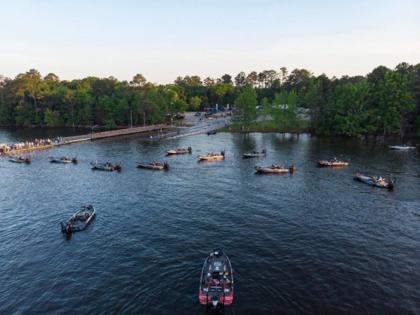South Carolina spends thousands to keep Lake Murray fishy. What does it get in return?
Published in Outdoors
COLUMBIA, S.C. — Visitors to Lake Murray are attracted by the copious varieties of fish under its blue waters, and officials are aware of this fact. That’s why they are taking steps to keep the aquatic population of the lake as high as possible.
Twenty-three “reef balls” — fabricated bits of concrete meant to stimulate fish habitat — have been deployed around Lake Murray, the S.C. Department of Natural Resources said in a news release.
The reef balls are dome-like molds about a foot and a half tall and two feet wide, with holes that allow fish to swim in and out of the structure. Once submerged, the balls form a “littoral habitat” that can provide the lake’s fish with space to spawn and attract food. The goal is for the balls to bolster the fish population at a time when natural habitats have been impacted by development, sedimentation, lack of vegetation and the aging of the reservoir, DNR said.
“Abundant and complex littoral habitat is critical to fish diversity, juvenile fish survival and ultimately the quality of our fish populations and recreational fisheries,” the agency said in a news release.
Fishing is a major attraction for visitors to Lake Murray. The artificial lake outside Columbia teems with largemouth bass, crappies and sunfish, and DNR spends an estimated $240,000 a year to make sure the lake is stocked with striped bass, releasing roughly a million of the fish popular with anglers into the lake each year. That’s because striped bass can’t reproduce naturally inside the lake.
“Striped bass need the right combination, because they have to run up the river to broadcast their eggs, and then the eggs float down the river, and when they hatch they need a certain area for abundant food sources,” said Jason Bettinger, DNR’s fisheries coordinator for the Midlands. “Those conditions aren’t met very often.”
The one place where the right conditions are met in South Carolina is the Santee River basin that includes Lake Marion and Lake Moultrie, where the designers of the reservoirs were surprised to learn that the bass could reproduce naturally in South Carolina’s other big, man-made lakes. For a while, this area was the source of several states’ supply of stripers, Bettinger said.
“We started making them and soon we’re shipping them around the Southeast,” he said. “We catch them outside Bonneau, fertilize them and put them in ponds in April, and then we stock in May or June.”
But even as the agency works to keep the level of fish in Lake Murray high, in recent decades it hasn’t studied the economic impact of all that bass. Bettinger said DNR had not formally looked at the wider impact of its fisheries since at least the 1980s.
“Obviously we would love to have that number, to demonstrate how important this resource is, but it’s large,” he said.
All those fish do draw fishing fans to the lake, however. Since 2001, the tourism agency Capital City/Lake Murray Country has hosted 26,000 professional anglers in different tournaments, with 12 more planned for 2025-26 — and that doesn’t count locally organized fishing competitions.
Those fishing pros have had a $35.9 million impact on the Midlands, Lake Murray Country estimates. The number grows to $61.3 million when factoring in the marketing value of those fishing tournaments airing on TV.
The economic impact far exceeds the $7,000 spent on the reef balls. DNR spent the money out funds collected from boat fuel taxes allocated to Newberry County.
The agency also does other things to try to maximize the fish population. Every year, they drop used Christmas trees into the lake as another way of creating artificial habitats for the fish. The holiday leftovers don’t just benefit the bass and crappies, but the fishers looking for them too.
“You can go to a location and know there’s a structure under there to attract fish,” Bettinger said.
©2025 The State. Visit thestate.com. Distributed by Tribune Content Agency, LLC.







Comments